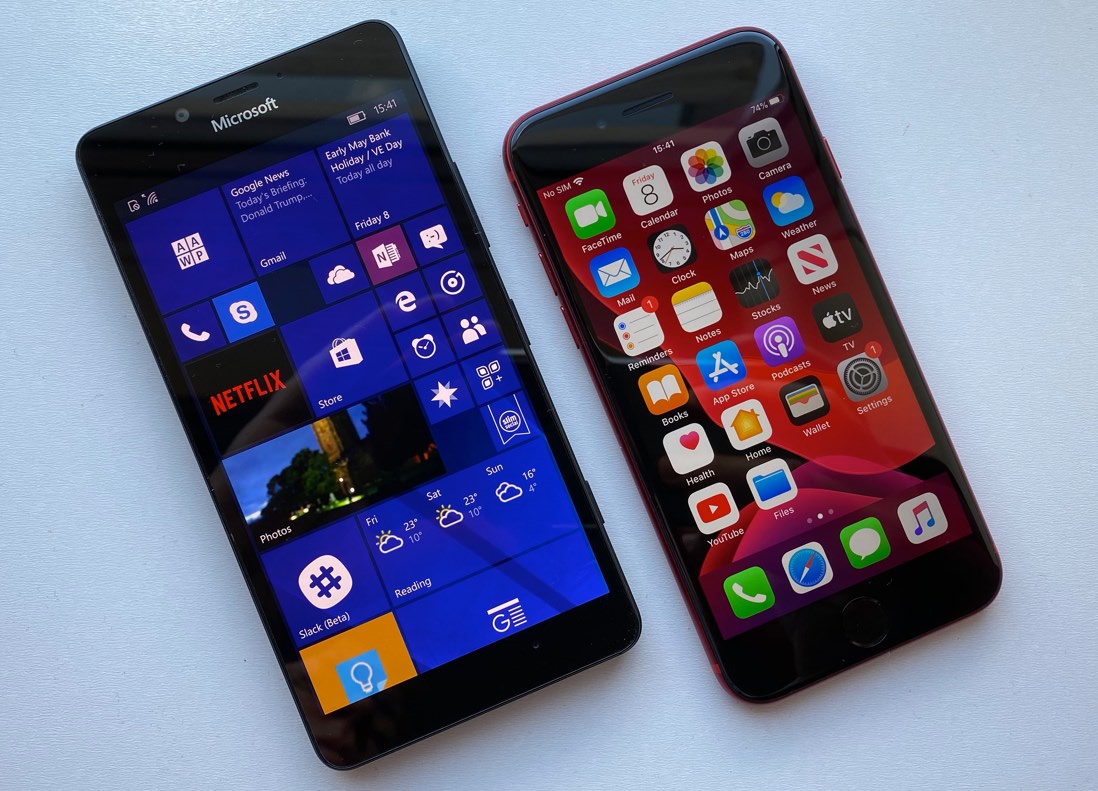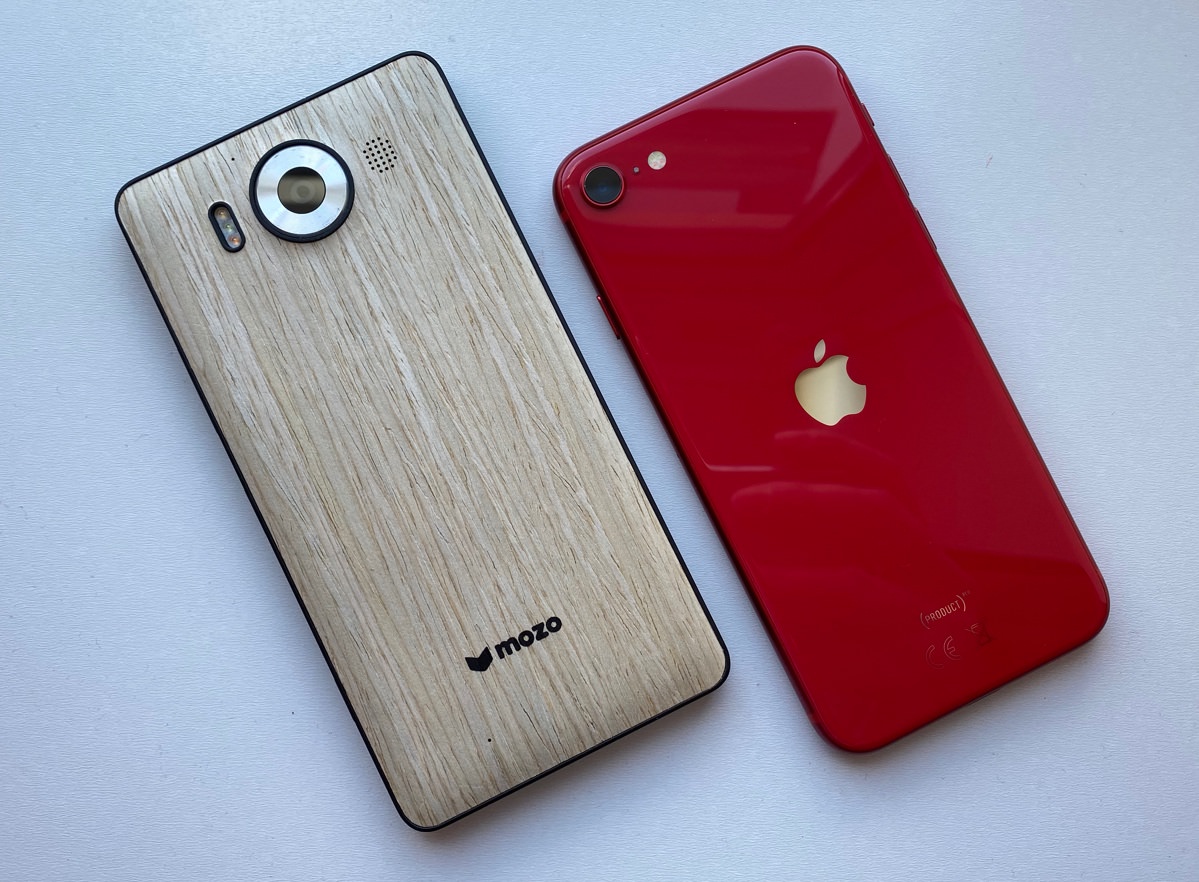
Lumia 950 and iPhone SE (2020)....
Up until now, switching to a new iPhone and embracing the rightful comprehensiveness of the iOS ecosystem has meant allowing for (at least) £730 (for the LCD-screened iPhone 11) and up to £1200 (for a 256GB iPhone 11 Pro with AMOLED screen). Ouch. It's a bit of a hit to the wallet. Yet the SE (2020) starts at £420 and for the most sensible 128GB version is still only £480. Not trivial, but you get an awful lot of smartphone for the money.
But how well does it match up to a classic Lumia? Looking at the specs - as usual, I've shaded in green an obvious 'win' for either device, and any row where a winner would be totally subjective is left uncoloured. Or, where all devices are utterly excellent but in different ways, I've given each a 'green'(!)
[By the way, if you're viewing this feature on a phone then the table may well cause you problems. Try viewing in landscape mode? Failing that, go view this on a laptop or tablet!]
| Microsoft Lumia 950 | Apple iPhone SE | |
| Date first available | November 2015 | April 2020 |
| Current price, availability | No longer officially for sale, though it's often on clearance prices if you're lucky and at outrageous profiteering prices due to rarity (if you're not!) | From £419 on Apple's site. |
| Dimensions, form factor, weight |
145 x 78 x 73mm, plastic chassis and replaceable backs (plastic/leather/wood etc, from Mozo, as modelled here!), 150g, bezels are comparatively small |
138 x 67 x 7mm, 148g, glass front and back, sealed as per modern smartphones. Slightly smaller than the 950, but similar weight. |
| Durability | No specific durability metrics, though the fact that the back comes off will help enormously for water damage, i.e. taking out battery and cards immediately, drying out the internals, even unscrewing the motherboard from the guts of the phone. I'm old-school here! All damage to the back or corners is trivial through replacement of the rear, but the screen's exposed, of course. If spare parts were all still available, all this would get a win here, but I notice that the likes of Replacebase have stopped listing replacement Lumia 950 screens, so it's all a little bit moot in 2020... |
IP67 water and dust proofing gets the win overall, though the all-glass construction does mean that a case is mandatory. |
| Operating system, interface | Windows 10 Mobile, (dismissable) virtual controls, as needed, now officially updated to W10 Fall Creators Update (Redstone 3, Autumn 2017) with security to 'January 2020'. No more updates, though, so we're at End of Support. |
iOS 13.4, gesture navigation, with on-screen 'home' indicator.
|
| Display |
5.2" AMOLED (1440p at 16:9 aspect ratio, matching most video media), Gorilla Glass 3, ClearBlack Display polarisers help with outdoor contrast, excellent viewing angles. Screen area is approximately 75cm2 Glance screen available (in various colours) for always-on time, day and notification icons, plus some detailed info from a specified app, give the Lumia the win here. |
4.7" 750p backlit LCD, 16:9 ratio, Gorilla Glass, screen area is roughly 61cm2
|
| Connectivity |
LTE, NFC (all uses), Wi-Fi b/g/n/ac, integral wifi tethering, Bluetooth 4.2 (all uses). Continuum connectivity to use a wide range of first and third party UWP apps on external displays as secondary screen, independent of the phone display. Includes the new NexDock 2, transforming the Lumia into a Windows 10 S laptop, effectively. |
LTE, NFC (just for payment), Wi-Fi b/g/n/ac/ax, integral wifi tethering, Bluetooth 5.0 (all uses). |
| Processor, performance | Snapdragon 808 chipset, 3GB RAM, decently smooth on the Fall Creators Update though still slower for almost everything than on the iPhone. Multi tasking and app resumption is excellent though, at least with all the modern UWP apps |
Apple A13 chipset, 3GB RAM, very fast at everything compared to the Lumia, things just happen instantly. |
| Capacity | 32GB internal storage, expandable via (cheap) microSD to extra 256GB | 64/128/256GB internal storage, depending on variant bought. |
| Imaging (stills) |
20MP PureView f/1.9 1/2.4" BSI sensor, Phase Detection auto-focus, dedicated camera shutter button and launch key, genuine 2x lossless digital zoom (in 8MP oversampled mode), OIS. 'Rich Capture' produces customisable HDR shots and 'dynamic flash', with triple LED illumination. Outstanding shots in most light conditions, with just focussing issues in low light as an Achilles heel. 5MP front camera, no auto-focus |
12MP f/1.8, PDAF, OIS, Quad LED flash 8MP, f/2.2 front camera, Dual Pixel autofocus Don't worry, there's an imaging comparison coming next, my gut feel so far is that it'll be a close run thing, so no winner here (yet)! |
| Imaging (video) | Up to 4K, optically (and optionally digitally) stabilised, with 'Best photo' 8MP grabbing built-in, plus Rich Recording and HAAC microphones for high quality, gig-level stereo capture. | Up to 4K video capture, optically and digitally stabilised and high quality stereo audio capture. |
| Music and Multimedia (speakers) |
A very average mono speaker by modern standards, though as ever you can trade volume for fidelity in a simple tweak on Lumias. |
Stereo speakers, or at least 'faux stereo', with bass mainly coming from the bottom component and just mids and top end coming from the earpiece speaker. Still, it makes a satisfying sound for a phone, when watching YouTube or Netflix etc. |
| Music (headphones) |
3.5mm headphone jack, A2DP+AptX, so great wired and wireless headphone audio too. | 3.5mm audio was ditched by Apple a while ago, and indeed they don't even ship an adapter/DAC in the box anymore. Happily these are only a tenner on Apple's site, while you also get Lightning headphones in the box. Bluetooth audio is just A2DP, but good enough for most people. |
| Navigation |
Windows 10 Maps is now pretty mature and impressive, especially once you've learned the live traffic routine trick! Offline maps save a lot of data bandwidth for those on tight contracts or anyone in a low signal (data) area, and these get the win here. |
Apple Maps is pretty good, with real time traffic coming from TomTom (at least in the UK), though you have to be online all the time since only limited areas are cached. However, in the App Store, Google Maps is available and now the gold standard in phone navigation, offering true real time navigation around real time, low-level traffic issues, along with offline maps that auto-update. So just use this! |
| Cortana/Voice | Cortana is now mature and well integrated, though some functionality has been falling away, e.g. recognising ambient music, plus there are reliability concerns under Windows 10 Mobile. | Siri is baked in and works superbly, especially responding to 'Hey Siri' even in noisy environments. Google Assistant knows more about you, but Siri is still pretty damned helpful. |
| Battery, life | Removable 3000mAh battery, and the ability to change cells gets the win here, plus USB Type C Power Delivery (up to 3A, so 15W) and 1A Qi wireless charging built-in also helps enormously. However, a Lumia running Windows 10 Mobile will now discharge in 24 hours even if you don't use it much. |
Sealed 1820mAh battery, just about gets through a day, though depends on the use case for the phone. The Lightning port supports 15W (3A) charging, though you only get a 1A charger in the box. There's also Qi wireless charging for top-ups around the home or office, which helps a lot. Still, all this can't compensate for just swapping in a new battery in 10 seconds. |
| Cloud aids | Windows Photos syncs across all signed-in devices, subject to your OneDrive tariff (stingy, unless you have Office 365), should you have thousands of images in the system. Plus Windows 10 backs all your media, application data and settings to a separate backup folder system, tariff-free on OneDrive, for easy restoration on a new or factory reset phone. | Apple's iCloud Photos does very well to backup your data and settings, and well enough to archive all photos, but the latter is a bit confusing to a newcomer and I'd recommend doing what I've done with iPhones and simply install the Microsoft OneDrive application. This then archives all photos as it used to on Windows phones, and you also get all your old OneDrive files and images accessible, etc. (Office 365 status-permitting!) |
| File compatibility | As with all Windows phones, plugging into a Windows PC gives full drag and drop to the phone's user file system. Plugging into a Mac isn't trivial, though see here! | Plugging into a PC gives immediate basic Windows Photos importing, or you can use iTunes for more control of syncing media to and fro. Ditto on Mac, though things are a bit more integrated, plus you also then get AirDrop which 'just works' over Wifi to move big files backwards and forwards quickly without wires. |
| Biometrics | Iris recognition ('Windows Hello') works well unless you wear varifocals(!), but takes a couple of seconds (including an animation!) in real world use. There's also no official way of paying in shops using this, at least not in most of the world. |
Touch ID capacitive finger scanner under the display. Which works superbly, though it does enforce the bigger bezels mentioned earlier! Touch ID unlocks the phone and authenticates purchases, in the App Store or via Apple Pay in a shop. |
| Applications and ecosystem | Windows 10 Mobile has most (though not all) mainstream apps and services covered. Often third party clients are involved, mind you, there are companies who hate Microsoft so much that they simply refuse to write for Windows, it seems. And 'long tail' niche/boutique apps are hard to find for real world companies and shops. |
The might of Apple and iOS's app ecosystem - everything is available and almost always in first party form. Plus a surprising amount built in (or a tap away) from Apple, including their Office suite (Pages, Numbers, etc.) and their photo and video editing suites. And the Garage Band recording suite. |
| Upgrades and future | Windows 10 Mobile is now effectively out of support. From now on, it will be useable but with more and more service caveats applying. Still, 'end 2019' was a full four years since the Lumia 950 XL was launched, so it's hard to complain. |
iPhones traditionally get longer than average support in terms of updates, with five years being common. So the SE 2020 should still be receiving OS and security updates in 2025. |

Verdict
Adding up the green 'wins' (for fun?!) gives a resounding 10-5 win to the much newer device, unsurprisingly. But what's more interesting is in how many areas the two phones are equivalent. Am I being too outrageous in suggesting that an iPhone SE 2020 makes a good direct replacement for a Lumia 950? I don't think so - and the price is right, since you don't have to budget for some crazy £1000 flagship. Yet you still get much of the best of Apple's phones. And should you feel the need in a year's time to pass this to your partner or kids, then your data and apps and setup are all neatly in the iOS ecosystem and it's the work of a mouse click or screen tap to bring almost everything back onto an upgrade.
Your comments welcome, anyway.
PS. Watch this space for my imaging comparison!
